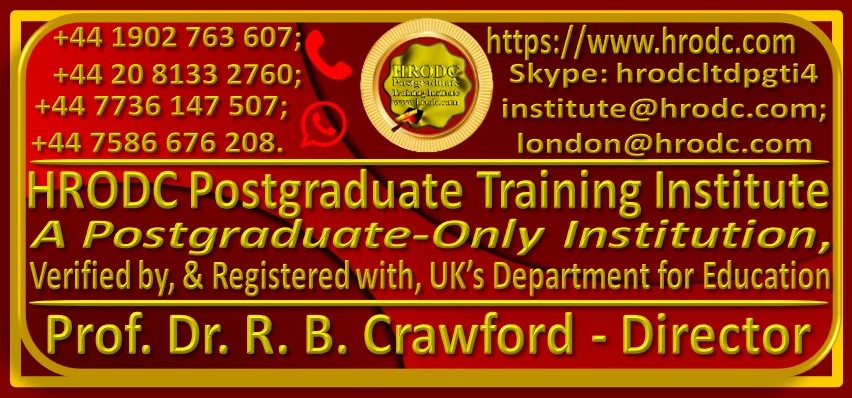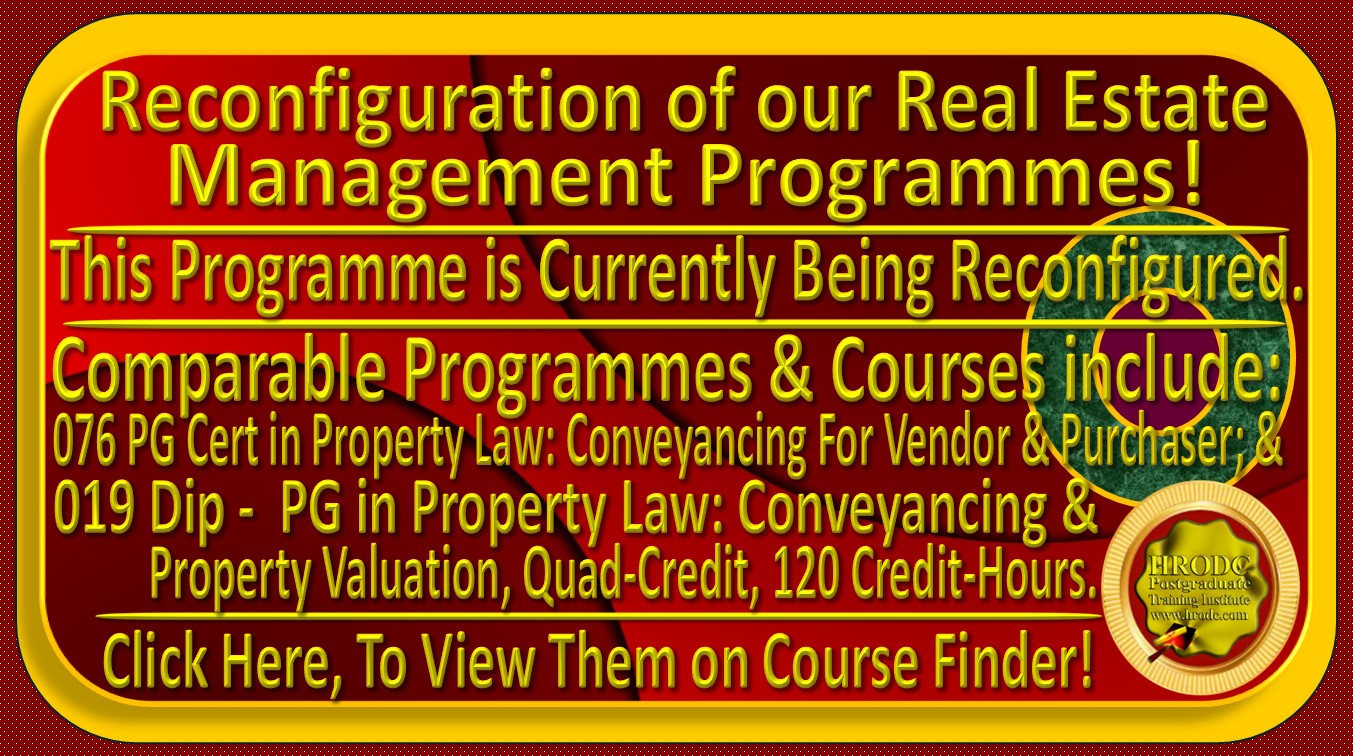|
Postgraduate Diploma in Real Estate Management |
|||||||||||||||||||||||||||||||||
Asset Managers; Auctioneers; Bankers; Business Rate Assessors; Buy-To-Let-Investors; Chartered Public Accountants; Chartered Surveyors; Chief Financial Officers; City Planning Officers; Commercial Property Investors; Commercial Real Estate Investors; Conveyancers; Conveyancing Solicitors; Corporate Accountants; Court Officers; Economic Planners; Electronic Conveyancers; Electronic Document Registration Service Providers; Electronic Identification Verification Service Providers; Electronic Lang Registry Operators; Enterprise Risk Managers; External Auditors; Financial Administrators; Financial Analysts; Financial Auditors; Financial Officers; Financial Risk Analysts; Financial Risk Managers; Freeholders; Fund Managers; Fundholders; Health and Safety Managers; Housing Cooperative Managers; Housing Department Officers; Housing Managers; Housing Trust Managers; Insurers; Internal Auditors; Joint Venture Investors; Joint Venture Operators; Land Authorities’ Officers; Land Registry Electronic Document Registration Service Providers; Land Registry Officers; Land Valuers; Leasehold Managers; Legislators; Licenced Conveyancers; Long-Term Lenders; Mineral Rights Officers; Mixed-Use Real Estate Investors; Monetary Officers; Mortgage Advisors; Mortgage Insurers; Mortgage Lenders; Mortgage Refinancers; Mortgagees; National Insurance Administrators; National Insurance Investors; National Insurance Security Specialists; Oil and Gas Estate Managers; Pension Fund Administrators; Pension Fund Administrators; Pension Fund Holders; Pension Fund Holders; Pension Fund Reviewers; Planning Agents; Port Authority Officers; Port Authority Property Managers; Property Administrators; Property Agents; Property Assessors; Property Auction Managers; Property Auctioneers; Property Brokers; Property Conveyancers; Property Developers; Property Engineers; Property Inspectors; Property Insurers; Property Investors, Property Marketing Agents; Property Registry Officers; Property Sales and Marketing Officials; Property Sales Personnel; Property Searchers; Property Surveyors; Property Tax Inspectors; Property Valuers; Real Estate Administrators; Real Estate Agents; Real Estate Auctioneers; Real Estate Conveyancers; Real Estate Developers, Real Estate Investment Trust Officers; Real Estate Managers; Real Estate Project Managers; Real Estate Property Managers; Real Estate Valuers; Real Property Experts; Realtors; Redemption Officers; Reinsurers; Rentowners; Residential Property Investors; Residential Real Estate Investors; Revenue Authority Managers; Revenue Authority Officers; Risk Managers; Social Security Risk Managers; Solicitors; Sovereign Wealth Managers; Stock Brokers; Stock Exchange Officers; Stock Exchange Operators; Stock Market Operators; Structural Surveyors; Subprime Mortgagees; Taxation Officers; Title Abstractors; Title Searchers; Value Engineers; Venture Capitalists, All others with an interest in Real Estate Management; Financial Risk Management; Property Management; Property Sales and Marketing and other related areas.
Doctor of Philosophy {(PhD) {University College London
(UCL) - University of London)};
MEd Management (University of Bath);
Postgraduate (Advanced) Diploma Science Teacher Ed.
(University of Bristol);
Postgraduate Certificate in Information Systems
(University of West London, formerly Thames Valley
University);
Diploma in Doctoral Research Supervision, (University of
Wolverhampton);
Teaching Certificate;
Fellow of the Institute of Management Specialists;
Human Resources Specialist, of the Institute of
Management Specialists;
Member of the Asian Academy of Management (MAAM);
Member of the International Society of Gesture Studies
(MISGS);
Member of the Standing Council for Organisational
Symbolism (MSCOS);
Member of ResearchGate;
Executive Member of Academy of Management (AOM). There,
his contribution incorporates the judging of
competitions, review of journal articles, and guiding
the development of conference papers. He also
contributes to the Disciplines of:
Human Resources;
Organization and Management Theory;
Organization Development and Change;
Research Methods;
Conflict Management;
Organizational Behavior;
Management Consulting;
Gender & Diversity in Organizations; and
Critical Management Studies. Professor Dr. Crawford has been
an Academic in the following UK Universities:
University of London (Royal Holloway), as Research
Tutor;
University of Greenwich (Business School), as Senior
Lecturer (Associate Professor), in Organisational
Behaviour and Human Resource Management;
University of Wolverhampton, (Wolverhampton Business
School), as
Senior Lecturer (Associate Professor), in Organisational
Behaviour and Human Resource Management;
London Southbank University (Business School), as
Lecturer and Unit Leader.
His responsibilities in these
roles included:
Doctoral Research Supervisor;
Admissions Tutor;
Postgraduate and Undergraduate Dissertation Supervisor;
Programme Leader;
Personal Tutor He was formerly an Expatriate
at:
Ministry of Education, Sokoto, Nigeria;
Ministry of Science and Technical Education, Sokoto,
Nigeria;
University of Sokoto, Nigeria;
College of Education, Sokoto, Nigeria; and
Former Editor-In-Chief of ‘Sokoto Journal of Education’.
Accurately conduct an on-the spot commercial property valuation, taking pertinent factors into account; Accurately locate an organisation’s management and workers within the ‘internal-external-stakeholder-spectrum’; Address the extent to which external organisational accountability affect internal organisational dynamics; Address the implications of National, Regional and International Embargo on Import and Export and Service Dispensation. An understanding of the fundamentals of leadership and management; Analyse education, training and development programmes; Appreciate the important role of strategic accounting in business performance improvement. Appreciate the need to maintain a ‘generalised client/ customer information system’; Argue on the cost effectiveness of a structural survey; Ascertain the importance of considering counterparty risk in evaluating contracts; Assess the implications of the ‘Receivership’ of a company for its statutory, primary and secondary creditors; Assess the risk and uncertainty associated with alternative outcomes; Assist clients in solving their problems relating to products and service; Calculate risk in financial exposure; Calculate statistics from actual data ; Cite some risk within the financial institutions; Cite some strategies to manage transaction exposure; Cite Specific legislation and related cases relevant particular job design issues; Communicate effectively with clients, colleagues, juniors and managers; Compare property registration in the UK with that of at least one other country; Conduct a property valuation of a private property, with at least 80% accuracy; Conduct a risk assessment; Conduct individual and panel interviews; Conduct periodic and exit interviews; Construct a business plan that will be attractive to investors and fund managers; Construct a Completion Statement for the Seller; Create a match between individual capabilities and orientation, on the one hand, and job design features, on the other; Decide what workers or managers are likely to gain from Geographical Flexibility; Decide whether the rise and fall of local currency value has an effect on real estate; Defend the strategic importance of employee Resourcing; Define accountability in relation to the control and allocation of resources, internally and externally; Define authority generally but also with specific relation to superior-subordinate relationship; Define corporate governance in relation to the processes, customs, policies, laws and institutions affecting the way a corporation is directed, administered or controlled; Define, with examples, social organisations; Demonstrate a ‘working understanding’ of Mortgage and Mortgage Rates; Demonstrate a heightened understanding of Property ‘Charges’ and the legal bases of their registration; Demonstrate a heightened understanding of the organisation’s responsibility and accountability to its shareholders as primary stakeholders; Demonstrate a knowledge of Conveyancing in at least one other country; Demonstrate a working knowledge of the function and operation of a National Property Registry; Demonstrate an appreciation of important of welfare in the development of personnel management and human resource management; Demonstrate an awareness of International Electronic Conveyancing (E-Conveyancing) Initiatives; Demonstrate an understanding of ‘reasonable support’; Demonstrate an understanding of ergonomics in job design; Demonstrate an understanding of the bases of organisational typologies; Demonstrate an understanding of the concept of power and how it might be applied for the benefit of the organisation; Demonstrate an understanding of the difference that exists between ordinary and preference shares; Demonstrate an understanding of the issue of ‘responsibility’ and how it translates in superior-subordinate relationships in organisations; Demonstrate an understanding of the legal bases of Employee Resourcing; Demonstrate an understanding of the legal framework of client service; Demonstrate an understanding of the objective hierarchy; Demonstrate an understanding of value of front-line staff to organisational effectiveness; Demonstrate how financial exposure risk are managed; Demonstrate how financial risks are quantified; Demonstrate knowledge about mean and statistical mean; Demonstrate the relationship between a company’s legal status and its accounting reporting requirement, and the rationale on which this demand is based; Demonstrate their ability to conduct a human resource audit; Demonstrate their ability to conduct job analysis; Demonstrate their ability to contribute to the maintenance of customer/ client loyalty; Demonstrate their ability to determine the type of commitment that motivate particular individuals to join an organisation; Demonstrate their ability to initiate improvements in client service; Demonstrate their ability to lead a recruitment and Selection team; Demonstrate their ability to remain calm and courteous during unpleasant situations such as an encounter with an irate client; Demonstrate their expertise in leading a customer/client care team; Demonstrate their knowledge of the property regulation of at least one Borough; Demonstrate their understanding of an effective job design system; Demonstrate their understanding of function of the National Land Information Service; Demonstrate their understanding of how a local Property Registry operates; Demonstrate their understanding of legitimate authority and how managers can provide help to their subordinates, in this regard; Demonstrate their understanding of merits and demerits of Freehold properties, on the one hand, and leasehold on the other; Demonstrate their understanding of the benefits and drawbacks of individual employee Resourcing strategy; Demonstrate their understanding of the different employee resourcing strategy; Demonstrate their understanding of the importance of employee Resourcing in an organisational context; Demonstrate their understanding of the local money market; Demonstrate their understanding of the phases of foreclosure or repossession; Demonstrate their understanding of the relationship between organisational tasks and objectives; Demonstrate their understanding of what real estate management entails; Demonstrate understanding of different type and levels of organisational flexibility, from an Industrial Relation or Employee Relations prospective; Demonstrate understanding of distinction between personnel management and human resource management; Demonstrate understanding of strategic planning and decision-making framework; Describe asset behaviour and pricing implication; Describe financial risk in the organisational setting; Describe the legal and political risk environment; Design an effective induction package; Design job description and personnel specification for particular roles; Detail the factors that should be taken into account when conducting a commercial property valuation; Determine an investor’s reason for investing in a derivative security; Determine how corporate strategy leads to effective risk management; Determine how credit risks are calculated; Determine how to manage currency risk; Determine the factors influencing human resource planning; Determine the importance of operational ‘transparency’ in the face of the regulatory authorities’ demand and in the enhancement of shareholder and client confidence. Determine the links between corporate planning and human resource planning; Determine the most appropriate legal form for particular entrepreneurial setting; Determine The role of Trading Standards in dealing with consumer complaints; Determine the situation in which liquidity risk arises; Determine what constitutes a ‘non-binding’ contract, under The Unfair Terms in Consumer Contracts Regulations 1999; Determine when a full structural survey is necessary; Determine when credit risk arises; Determine when there is a need to review an organization human resource plans; Determine why settlement risk has been historically a particular problem in the foreign exchange markets; Develop a general strategy towards property marketing; Develop a strategy to manage the relationship between themselves and the vendor, on the one hand, and themselves and the purchaser, on the other; Develop operating and resource budgets; Develop profit and cash flow budgets using traditional and activity based methods; Devise an effective employee Resourcing strategy; Devise tactics for marketing specific properties; Discuss about future’s market risk; Discuss about sensitivity analysis as risk management; Discuss the reason for the existence of foreign currency market; Discuss the significance of statistics; Discuss what determines the extent to which the company is affected by economic exposure; Discuss which type of company is susceptible to transaction exposure; Distinguish between a basic survey and a full structural survey; Distinguish between business and non-business organisations; Distinguish between business objectives and social objectives; Distinguish between internal and external organisational accountability; Distinguish between primary and secondary objectives; Distinguish between the different types of job design; Distinguish between the different types of job design; Distinguish between winding up or insolvency, Bankruptcy, Receivership, and Administration; Draft a legally binding Conveyancing contract; Draw a parallel between material and facilities Resourcing and people Resourcing, from the standpoint of organisational effectiveness; Draw on cases of Deeds default and their resultant consequences; Enhance capability of arriving at objective decisions in personnel Selection; Enumerate some sources of operating risk; Enumerate the different kinds of banking risk and explain each; Establish the array of issues that are enshrined in a company’s ethical behaviour; Establish the link between financial risk and the market dynamics; Establish the link between risk and equity market; Establish the primary role of technology in risk management; Establish the role that real estate plays in depressed economies; Evaluate investments in capital and long-term projects using PB, ARR, NPV and IRR appraisal methods; Exhibit a ‘functional’ level of interpersonal relationship; Exhibit a heightened awareness of the organisation’s accountability to its Board of Directors; Exhibit a heightened knowledge of the support that managers should provide to ‘delegatees’, to enhance the performance of their roles; Exhibit a heightened understanding of the ways in which the organisation is accountable to its clients/users and customers, their expectations, and the effort the organisation can make to meet their expectations, so as to avoid negative consequences of any deficiency; Exhibit a willingness to seek help and advice from colleagues and managers, when faced with difficult situations; Exhibit an appreciation of the need for a professional and caring relationship between the Conveyancer and his or her client, throughout the Conveyancing process; Exhibit an awareness of the high standard of service, which each client anticipates; Exhibit an understanding of the desirability of a limited turnover of staff; Exhibit an understanding of the different power centres that exist in an organisation and, their legitimacy and effect on organisational stability and flexibility to respond effectively to a crisis; Exhibit an understanding of the factors that constitute an effective real estate management; Exhibit an understanding of the functioning of a ‘client-driven organisation’; Exhibit an understanding of what constitutes the rights and equitable treatment of shareholders; Exhibit competence in fundamental aspects of customer/ client service - incorporating sensitivity to clients’ needs; Exhibit leadership in dealing with ‘the irate customer/ client’; Exhibit the extent to which social objectives enhance business objectives; Explain how the interests of secondary stakeholders can be preserved; Explain how the second facet of authority might be enhanced and the responsibility that managers have to their subordinates, in relation to their organisational positions and roles; Explain probability and normal distribution; Explain the concept of Chi-Squared Distribution; Explain the degree to which a formal management succession chart can enhance the effectiveness of the process of delegation; Explain the different statutory agencies to which an organisation is accountable, providing advice regarding how the organisation can benefit from co-operating with them, in relation to their requirement and expectations; Explain the entrenched practice regarding ‘fixtures and fittings’ or chattel, in residential property sale; Explain the issue of accountability, in relation to the organisational hierarchy; Explain the nature and role of financial statements and their interpretation; Explain the order in which the proceeds of a company’s assets will be distributed among its creditors, in the event of it falling into ‘Receivership’; Explain the requirements of HIPS, outlining their values and drawbacks; Explain the underlying principle of financial risk management; Explain the way in which the organisation is accountable to its owners (partners, shareholders) or sponsors and the negative implications that they can yield if their expectations are not met; Explain traditional authority and how it translates to organisational relationships; Explain why particular ‘aspects’ should be included in the Business Plan, to enhance its effectiveness; Explore the bases for ‘division of work/ labour’ in organisations and their relation to organisational effectiveness; Expound the facet of authority, providing practical examples ; Find out how statistical analysis is used as a risk management instrument; Find out how the interest rate derivatives market are managed; Give the general definition of risk; Have designed ways of stabilizing staff turnover/high turnover; Highlight the developmental opportunities that delegation provides for subordinates; Identify and measure currency risk; Identify some financial methods of measuring risk; Identify sources of power in organisation and their implications for effective management and organisational control; Identify the features of the alternative sources of business financing; Illustrate how a well-constructed Business Plan might be used to Attract Investors and ‘Fund Holders’; Illustrate the ‘balance’ that might be made between candidate immediate suitability and the possibility of Continuous Professional Development (CPD). Illustrate the channels of economic exposure; Illustrate the difference between the Hard approach to HRM and Soft approach to HRM; Illustrate the legal bases of job design; Illustrate the models towards understanding risk; Illustrate the problems and benefits of different legal form of companies; Illustrate the significance of effective human resource; Illustrate the symbiotic relationship between power and authority, in relation to ‘managerial leaders’ in the performance of their organisational roles. Illustrate their ability to manage internal and external customer/client care environments; Illustrate their understanding of the need to Empower Front-line Staff to Redress ‘Dissatisfactory Client/ Customer Situations’; Incorporate the notion of ‘market value’ in property valuation; Indicate how human resource planning can support business systems; Indicate the benefits of functional flexibility of workers and managers; Indicate the effects of risk in the economy; Indicate the factors that contribute to fatigue and fatigue reduction; Indicate the legal requirement associated with International Trade in their own country; Indicate the part that real estate management plays and can play in expanding economies; Indicate the phase of foreclosure or repossession that the mortgagee loses control of the property; Indicate The Powers of the Office of Fair Trading, under the Unfair Terms in Consumer Contract Regulations 1999; Indicate the relationship between Temporal Flexibility and Financial Flexibility; Indicate the significant aspects in development of human resource management and personnel management; Indicate their understanding of the operations of the international money market; Indicate when translation exposure occurs; Indicate, accurately, the statutory reporting requirements of a company, based on its legal status and in relation to their specific country; Interpret statistical data; Link employee Resourcing with business and organisational development; List the pertinent factors that are associated with a choice of legal status of a company; Manage recruitment and selection within a ‘resourcing context’. Manage risk with forward contracts; Manage risk with SWAPS; Manage the strategic role; Obtain and evaluate documents from ‘Land Register Online’ ; Offer advice to managers regarding the aversion or reduction of conflict the ‘Legal-Professional Authority’ mix pose, so as to enhance organisational effectiveness; Outline salient steps that can be taken to preserve an organisation’s integrity; Outline the importance of individual readiness in the success of the delegation process; Outline the legal requirement for company formation, as it pertains to their particular country; Outline the merits and demerits of Freehold and Leasehold property ownerships; Outline the roles and responsibilities of the Board of Directors; Outline the value of delegation to the ‘delegate’; Produce a Completion Statement for the Buyer; Propose varying definitions of an organisation; Provide ‘contingencies’ based on differing business scenarios. Provide a non-technical explanation of pertinent clauses in Deeds and Covenants; Provide a strategic view of the business environment; Provide a working definition of accountability; Provide advice to managers on the extent to which delegation should relate to the ‘informal management succession’; Provide an objective view of the result of a property inspection; Provide basic advice to clients on the suitability of mortgage type, based on particular circumstances; Provide examples of the legal application of ‘Fitness For Purpose’; Provide guidance to entrepreneurs on how to adapt a business plan to meet changing circumstances, without losing its focus; Provide real examples of the relationship that an organisation has with its sector or industry, the requirements to adhere to codes of practice and the ‘business case’ for their adherence to established expectations; Provide relevant guidance to buyers and sellers, on Property Auctions; Provide the rationale for the organisation’s accountability to its creditors, their expectations, possible negative consequences for non-compliance, and the steps that a company should take to adhere to them; Recall fundamental elements of the ‘Sale of Goods Act 1979’; Recall important points of law in the Unfair Terms in Consumer Contract Regulations 1999. Recall the obligation of the producer of goods and service, under the ‘Sale of Goods Act 1979’; Recall the obligation of the service provider/ product retailer, and manufacturer under The Supply of Goods and Services Act 1982; Recall the obligations of the retailer/ service provider under the ‘Sale of Goods Act 1979’; Relate corporate governance to the relationships that persists between internal and external stakeholders, particularly in relation to the establishment of organisational goals and objectives; Relate job design factors to the law; Relate specific recruitment, selection, retention and exit issues to UK and European legislation; Relate the factors to be taken into account to ensure that job design tribute to organisational success; Relate the normal or standard percentage of market value that a property is sold at the Real Estate Owned by Lender (REO) stage. Relate the part played by Cadburys Rowntree in the development of personnel management and human resource management; Relate the pertinent factors in private property valuation; Review the financial performance and financial position of an organisation using the appropriate financial means including trend analysis, industry and index analyses, ratio and break-even analysis techniques; Specify risks that are associated with socio-cultural change; Specify some qualitative approaches to financial risk assessment; Specify what are involved in managing fraud risk; Suggest effective means by which internal promotion should be handled; Suggest the constraints that specific UK Protective Legislation place on the recruitment, selection and management of employees; Suggest the effect that depressed economies have on real estate management; Suggest the general statutory accounting requirement of a company in their country and the factors that determine these requirements; Suggest the importance of human resource planning in organisation management; Suggest the role of the Office of Fair Trading (OFT), in dealing with consumers’ complaints under The Unfair Terms in Consumer Contracts Regulations 1999; Suggest what Numerical Flexibility means; Suggest whether the Scottish ‘Blind-Bidding System’ averts the practise of Gazumping. Synthesize current or suggested information to make predictions on the extent to which a particular economic trend is likely to affect, negatively or positively, real estate value; Take a holistic approach to property marketing; Take a scientific approach to property inspection; Uncover likely deceptive issues that influence property valuation; Understand accounting and finance terminology and use the necessary accounting and financial jargon to communicate effectively with the financial professionals; Use available data to undertake basic financial analysis; Use budgetary control to compare actual against planned performance and to identify corrective actions; Use candidate assessment form in short listing and Interviews; Use given information to undertake a real-life financial analysis; Use PESTEL in risk management. Weight a candidate assessment form, on the basis of job description and personnel specification.
|



























